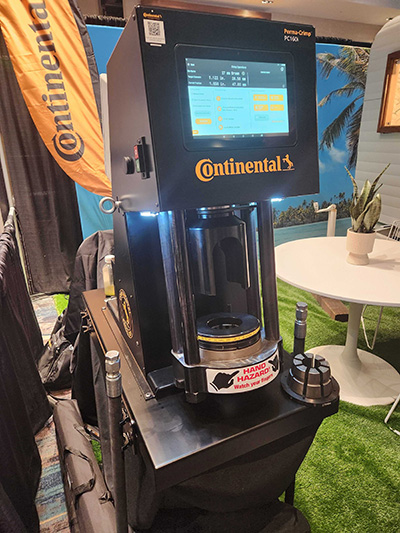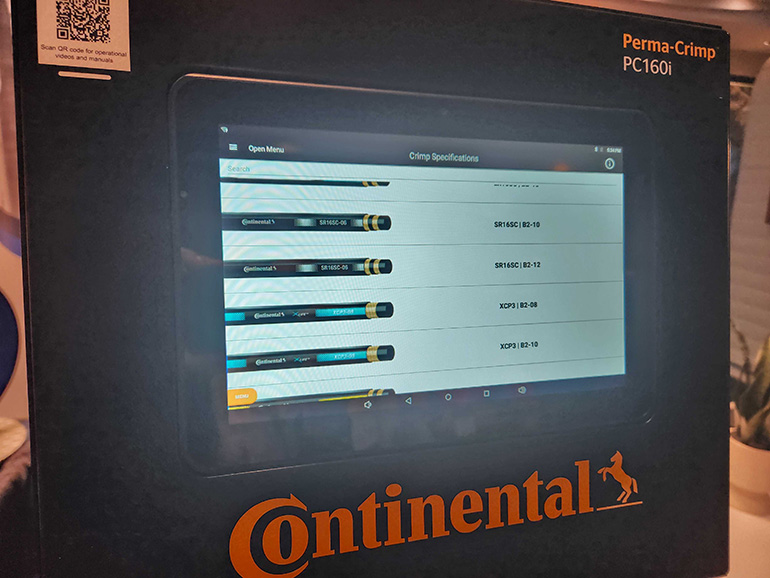At NAHAD last week, Continental officially launched its newest crimper, the PC160i with CrimpIQ PRO Technology. The bench-top 1 ¼ in. crimper features state-of-the-art technology to make hose crimping quick and easy.
Laszlo Dobo, Head of Product Management – Hydraulic Solutions, noted that the original smart crimper from Continental was launched in 2018, and over the past six years, the technology has evolved. “With six years in operation we gathered all the feedback, and basically developed a new version of the CrimpIQ software,” Dobo said.

The key to this new crimper is that it only requires three clicks to crimp, simplifying the process and mimicking swipe technology most of us are familiar with. Dobo compared the software and process to using a smart phone and its apps.
“Since we live 24 hours with hoses and crimping, we believe that crimping is not rocket science. It could be intimidating at first, especially the older technology,” Dobo said. “But our goal with this development is to make crimping easy. We know that most of our customers are talking about the fluctuation of the workforce. The challenge in finding people. They need to go through a significant amount of training to be able to crimp a proper hose.”
The software and process is extremely intuitive, Dobo said. “We call it three taps, meaning that you need to tap only three times and then you will be able to quicky crimp a hose,” Dobo said. “The crimper has a nice tablet. You have visual guides to help you go through the selection of the hose type, the die types, and then, the crimper will be able to crimp it to the right specifications.”
The service crimper features color-coded dies which are quick, safe and easy to remove for easy operator change-out. You simply match your hose lay line to the correct hose on the screen, then choose your correct die and begin the crimp process. The three-tap process eliminates the pain point of setting a micrometer. Because it comes with a 12-month subscription to the CrimpCloud, all crimp charts are live and updated in real time.
Additional features include a new toggle switch for up and down operation, along with included foot-pedal as an additional method to actuate the crimper. It also has the capability to print a label with QR code, to make future hose assembly replacements easy so you know what hose and fittings were used without all the guesswork, said Dobo.

The crimper is designed for hydraulic hose but the software itself has come specifications for industrial hoses.
Having the live connection to the CrimpCloud means technicians no longer need to rely on printed specifications that might be outdated, which can result in the wrong crimp. “Whenever we make a design change or a crimp specification change, then we update this information,” Dobo said. “And wherever you are, you’ll be able to pull this information down. It is like running an update on your iPhone or Android. It’s just as easy.”
In addition to the safety, security, and speed provided by the smart crimping technology, you also reduce waste, said Dobo, because you’re eliminating the chance of mis-crimping a hose and fitting assembly, which otherwise would be trashed if done improperly.
The PC160i with CrimpIQ PRO Technology is being manufactured in Valparaiso, Indiana, which was part of Continental’s Custom Machining Services acquisition in 2017, said Jim Hill, VP, Marketing & Strategy. This is a greater part of expanding Continental’s presence and reach in the hydraulics market, as it grows its hose offerings to encompass fittings and crimping technology.
“The crimper is one piece of the overall puzzle,” said Hill. “But we’ve also making significant investment in a new manufacturing facility down in Aguascalientes, Mexico.”
Continental’s ContiTech division currently has six manufacturing plants already in Central Mexico. “The Aguascalientes plant is a $90 million investment primarily focusing on wire-braided and wire-spiral hoses for the hydraulic industry, but it’s really there to complement our Norfolk, Nebraska plant, which is where we make most of our braided hydraulic hose today that we sell here,” Hill added. “They’re going to keep making hose and this is an expansion for added capacity to complement Norfolk.
“We had been getting a lot of our hose from China. But we just want to be in the region for the region, so we needed new capacity. We wanted shorter supply chain lines. And we wanted to have a hydraulic hose manufacturing plant in the Americas for our business area here.”
The Chinese plant will continue to supply the Asia Pacific market, Hill said, and the European plants will focus on that region. “Having the ability to make our own product here, having shorter supply chains, having much more capacity, all helps us grow our hydraulics business in a big way. And then adding new things like this new crimper just continues to evolve our position to become a more significant player in one of the largest markets in the Americas,” Hill said.
Hill noted that this deeper concentration on the ContiTech industrial division comes with a reorganization of how the different industrial products are led at a corporate level and brought to market.
“One of the big things we’re trying to become is more customer centric, to wrap or bundle all these products together and offer them as one offering to the market because when it comes to this space, Continental has the biggest and broadest product offering out there,” Hill concluded. “We’re the only ones that offer industrial hose, hydraulic hose, conveyor belts, power transmission, air springs. We want to leverage that in the new organization and be as customer centric as possible.”
Continental
continental.com
Filed Under: Components Oil Coolers, Hose & Tubing, Hose Assembly Tips, Technologies